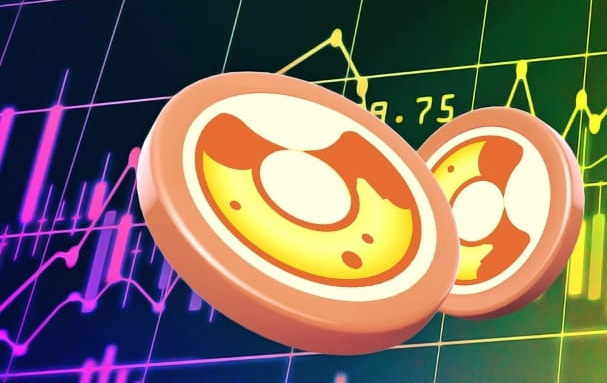-
 Bitcoin
Bitcoin $103,617.9038
-0.05% -
 Ethereum
Ethereum $2,486.4253
-3.30% -
 Tether USDt
Tether USDt $1.0002
0.01% -
 XRP
XRP $2.3618
-3.31% -
 BNB
BNB $650.3058
-0.89% -
 Solana
Solana $171.7622
-1.64% -
 USDC
USDC $1.0000
0.01% -
 Dogecoin
Dogecoin $0.2302
-5.52% -
 Cardano
Cardano $0.8036
-2.55% -
 TRON
TRON $0.2647
0.73% -
 Sui
Sui $3.9833
-1.07% -
 Chainlink
Chainlink $16.9285
-2.39% -
 Avalanche
Avalanche $24.5918
-3.79% -
 Stellar
Stellar $0.3052
-2.31% -
 Shiba Inu
Shiba Inu $0.0...01583
-3.27% -
 Hedera
Hedera $0.2047
-5.28% -
 Toncoin
Toncoin $3.3588
-2.65% -
 Hyperliquid
Hyperliquid $25.0206
-1.92% -
 Bitcoin Cash
Bitcoin Cash $407.5306
-4.61% -
 Pi
Pi $1.1400
50.15% -
 Polkadot
Polkadot $5.0703
-1.72% -
 UNUS SED LEO
UNUS SED LEO $8.3478
-1.18% -
 Litecoin
Litecoin $99.6661
-4.41% -
 Monero
Monero $332.0739
2.83% -
 Pepe
Pepe $0.0...01356
0.66% -
 Bitget Token
Bitget Token $4.8601
-0.91% -
 Dai
Dai $0.9999
-0.02% -
 Ethena USDe
Ethena USDe $1.0002
-0.01% -
 Uniswap
Uniswap $6.8673
-2.55% -
 Bittensor
Bittensor $450.2916
-2.04%
How to buy, sell and trade BAKE coin? Detailed tutorial
To purchase BAKE, establish an account on a reputable exchange like Binance, fund it with fiat currency, identify the proper BAKE trading pair, and place a market or limit buy order.
Nov 07, 2024 at 10:36 pm

How to Buy, Sell, and Trade BAKE Coin: A Comprehensive Guide
BAKE is the native token of BakerySwap, a decentralized exchange running on Binance Smart Chain (BSC). It acts as a governance token that grants voting rights to its holders and offers incentives to those staking it or using BakerySwap services. If you're interested in acquiring or trading BAKE, here's a step-by-step tutorial to guide you through the process.
Buying BAKE Coin
- Choose a Cryptocurrency Exchange: BAKE is traded on various cryptocurrency exchanges. Select a reputable exchange that supports BAKE trading, such as OKX, Binance, or Huobi Global.
- Create an Account: Register an account with the exchange and complete the necessary identity verification procedures.
- Fund Your Account: Deposit funds into your exchange account to purchase BAKE. Most exchanges support fiat currency deposits using credit or debit cards or bank transfers.
- Find BAKE Trading Pair: Navigate to the exchange's spot trading section and search for the BAKE trading pair with your preferred currency (e.g., BAKE/USDT).
- Place a Buy Order: Enter the amount of BAKE you want to buy and select a market or limit order. A market order executes immediately at the current market price, while a limit order specifies a price point at which you wish to buy.
Selling BAKE Coin
- Go to Spot Trading: Navigate to the spot trading section of the exchange you used to buy BAKE.
- Select BAKE Trading Pair: Find the trading pair associated with the BAKE you want to sell (e.g., BAKE/USDT).
- Place a Sell Order: Enter the amount of BAKE you wish to sell and choose a market or limit order. A market order sells immediately at the current market price, while a limit order sets a desired price point for selling.
Trading BAKE Coin
- Create a Trading Account: Open a trading account on a reputable exchange to trade BAKE. Consider factors such as leverage options, trading fees, and customer support.
- Fund Your Account: Transfer funds to your trading account to margin trade BAKE.
- Select Trading Pair: Find the trading pair for the BAKE market you wish to trade (e.g., BAKE/USD).
- Set Leverage: Most trading platforms offer leverage options for margin trading. Select the leverage appropriate for your trading strategy. However, leverage increases both potential profits and risks.
- Open a Position: Determine the direction of the trade and open a long (buy) or short (sell) position.
- Monitor Position: Regularly monitor market conditions and adjust your position or close the trade as needed to manage risks and profit.
Disclaimer:info@kdj.com
The information provided is not trading advice. kdj.com does not assume any responsibility for any investments made based on the information provided in this article. Cryptocurrencies are highly volatile and it is highly recommended that you invest with caution after thorough research!
If you believe that the content used on this website infringes your copyright, please contact us immediately (info@kdj.com) and we will delete it promptly.
- Bring Me The Horizon’s Oli Sykes and partner Alissic announce they are expecting twins.
- 2025-05-12 07:20:13
- Best Meme Coin Presales to Buy This Week—Troller Cat's Game Center Ignites While Dogwifhat, AI Companions Hold
- 2025-05-12 07:20:13
- Trump's Red, White, and Meme-Colored Curveball Derails GENIUS Act
- 2025-05-12 07:15:12
- BTFD Coin (BTFD) – Where Bulls Triple Their Bags
- 2025-05-12 07:15:12
- BTFD Coin: The Breakout Meme Coin That's Turning Heads
- 2025-05-12 07:10:13
- PEPE Price Prediction: Analyst Forecasts Dogecoin-Style Rally Above $10 Billion
- 2025-05-12 07:10:13
Related knowledge

What is Ethereum’s Slashing mechanism and how to punish malicious behavior?
Feb 20,2025 at 03:08am
Key PointsOverview of slashingDifferent types of slashing in EthereumIncentives and consequences of slashingIdentifying and reporting slashed validatorsOngoing discussions and potential improvementsEthereum's Slashing Mechanism: Punishing Malicious BehaviorEthereum's slashing mechanism is an essential tool for ensuring network security and punishing mal...

What is the verifier node of Ethereum and how to become a verifier?
Feb 19,2025 at 06:00pm
The Verifier Node of Ethereum: A Comprehensive GuideKey Points:What is a Verifier Node?How to Become a Verifier NodeResponsibilities and Rewards of a Verifier NodeMinimum Requirements for Becoming a Verifier NodePotential Difficulties in Running a Verifier Node1. What is a Verifier Node?A Verifier Node is an independent entity on the Ethereum network th...

What is Ethereum’s staking, and how to participate and earn money?
Feb 19,2025 at 04:37pm
Key Points:Understanding Ethereum's Staking MechanismSteps to Participate in StakingBenefits and Rewards of StakingSecurity and Risk ConsiderationsTechnical Requirements and Hardware OptionsPotential Challenges and Troubleshooting TipsFAQs on Ethereum StakingWhat is Ethereum's Staking?Proof-of-Stake (PoS) is a consensus mechanism used in blockchain netw...

What is Ethereum’s DAO (Decentralized Autonomous Organization) and how does it work?
Feb 20,2025 at 03:12am
Key PointsDefinition and Structure of a DAOGovernance and Decision-Making in DAOsBenefits and Use Cases of DAOsChallenges and Limitations of DAOsWhat is Ethereum's DAO (Decentralized Autonomous Organization) and How Does It Work?Definition and Structure of a DAOA Decentralized Autonomous Organization (DAO) is an innovative governance and management fram...

What is Ethereum's multi-signature wallet and how to improve security?
Feb 20,2025 at 02:18pm
Key Points:Understanding the Concept of a Multi-Signature WalletBenefits and Drawbacks of Multisig WalletsRequirements for Setting Up a Multisig WalletStep-by-Step Guide to Generating a Multisig WalletImplementing Strategies for Enhanced Security1. Understanding the Concept of a Multi-Signature WalletA multi-signature (multisig) wallet in the Ethereum e...

What is Ethereum's oracle and how to provide data for smart contracts?
Feb 21,2025 at 01:30am
Key Points:Understanding the concept of oracles in EthereumExploring different types of oraclesDetailed guide on how to provide data for smart contractsAddressing potential challenges and considerationsWhat is Ethereum's Oracle?Oracles are crucial components in the Ethereum ecosystem, enabling smart contracts to access real-world data and off-chain even...

What is Ethereum’s Slashing mechanism and how to punish malicious behavior?
Feb 20,2025 at 03:08am
Key PointsOverview of slashingDifferent types of slashing in EthereumIncentives and consequences of slashingIdentifying and reporting slashed validatorsOngoing discussions and potential improvementsEthereum's Slashing Mechanism: Punishing Malicious BehaviorEthereum's slashing mechanism is an essential tool for ensuring network security and punishing mal...

What is the verifier node of Ethereum and how to become a verifier?
Feb 19,2025 at 06:00pm
The Verifier Node of Ethereum: A Comprehensive GuideKey Points:What is a Verifier Node?How to Become a Verifier NodeResponsibilities and Rewards of a Verifier NodeMinimum Requirements for Becoming a Verifier NodePotential Difficulties in Running a Verifier Node1. What is a Verifier Node?A Verifier Node is an independent entity on the Ethereum network th...

What is Ethereum’s staking, and how to participate and earn money?
Feb 19,2025 at 04:37pm
Key Points:Understanding Ethereum's Staking MechanismSteps to Participate in StakingBenefits and Rewards of StakingSecurity and Risk ConsiderationsTechnical Requirements and Hardware OptionsPotential Challenges and Troubleshooting TipsFAQs on Ethereum StakingWhat is Ethereum's Staking?Proof-of-Stake (PoS) is a consensus mechanism used in blockchain netw...

What is Ethereum’s DAO (Decentralized Autonomous Organization) and how does it work?
Feb 20,2025 at 03:12am
Key PointsDefinition and Structure of a DAOGovernance and Decision-Making in DAOsBenefits and Use Cases of DAOsChallenges and Limitations of DAOsWhat is Ethereum's DAO (Decentralized Autonomous Organization) and How Does It Work?Definition and Structure of a DAOA Decentralized Autonomous Organization (DAO) is an innovative governance and management fram...

What is Ethereum's multi-signature wallet and how to improve security?
Feb 20,2025 at 02:18pm
Key Points:Understanding the Concept of a Multi-Signature WalletBenefits and Drawbacks of Multisig WalletsRequirements for Setting Up a Multisig WalletStep-by-Step Guide to Generating a Multisig WalletImplementing Strategies for Enhanced Security1. Understanding the Concept of a Multi-Signature WalletA multi-signature (multisig) wallet in the Ethereum e...

What is Ethereum's oracle and how to provide data for smart contracts?
Feb 21,2025 at 01:30am
Key Points:Understanding the concept of oracles in EthereumExploring different types of oraclesDetailed guide on how to provide data for smart contractsAddressing potential challenges and considerationsWhat is Ethereum's Oracle?Oracles are crucial components in the Ethereum ecosystem, enabling smart contracts to access real-world data and off-chain even...
See all articles





















































































